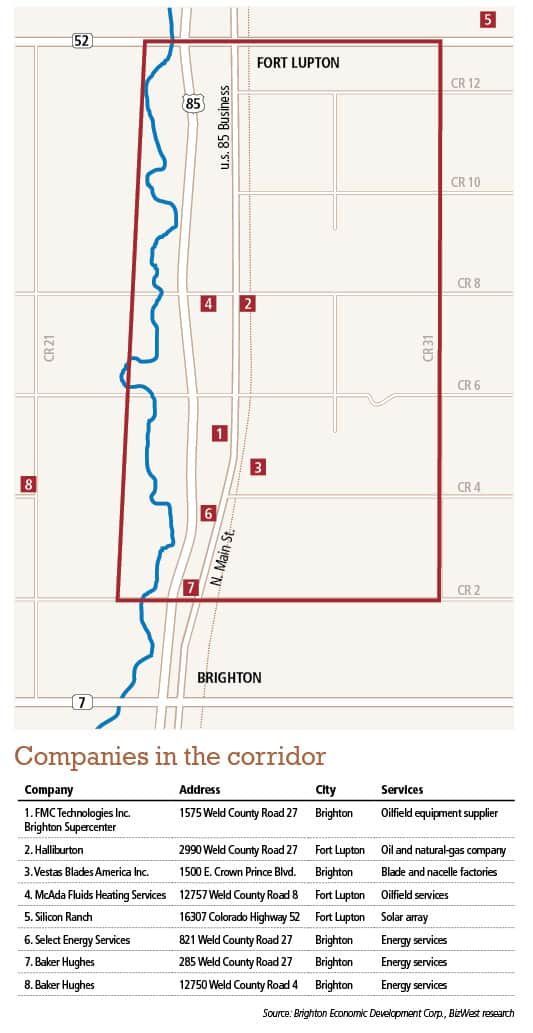Energy Corridor prospects brighten

BRIGHTON — About five miles of U.S. Highway 85 stretch between Fort Lupton and Brighton, at least between their existing residential areas. As things usually go with emerging communities along the Front Range, that should be a lot of room to fight over — but that simply has not been the case here.
“The nice thing between Brighton and Fort Lupton is we have a good rapport,” said Michael Martinez, economic development specialist for the Brighton Economic Development Corp. “It really has been key for us both, having that kind of communications between the two communities.”
The event that began to forge that kind of cooperation was international wind-energy giant Vestas Wind Systems locating in Brighton. Subsequently, the two cities signed an intergovernmental agreement (IGA) in 2009, with both looking to create an energy-business corridor in that intervening area.
SPONSORED CONTENT
How Platte River Power Authority is accelerating its energy transition
Platte River Power Authority, the community-owned wholesale electricity provider for Northern Colorado, has a history of bold initiatives.
 “A portion of the (Vestas) property was actually in Fort Lupton, so the current IGA came about because of Vestas,” Martinez said. But while Brighton certainly took the cake in the first go-around, there have been several wins for Fort Lupton as well, including keeping the town’s biggest employer, Halliburton, in the city.
“A portion of the (Vestas) property was actually in Fort Lupton, so the current IGA came about because of Vestas,” Martinez said. But while Brighton certainly took the cake in the first go-around, there have been several wins for Fort Lupton as well, including keeping the town’s biggest employer, Halliburton, in the city.
Halliburton was looking to expand the facilities it had in Fort Lupton early in this decade and had considered locating in Greeley or even Wyoming. Fortunately for Fort Lupton, it was able in 2011 to convince the oil-and-gas giant to locate its new facility in this “energy corridor” by some rather innovative means.
“That was very much an ‘out-of-the-box’ deal,” noted Aaron Herrera, assistant city manager in Fort Lupton. “We had to borrow the money from Halliburton to extend the sewer and water two-and-a-half miles.”
In essence, those two deals mean that much of what the Brighton EDC calls the “energy and employment corridor” is pretty much open for business, with public infrastructure already in place. Essentially, the corridor is a 3,000-acre area between the two cities, delineated by U.S. 85 to the west and the old U.S. 85, or U.S. 85 Business, which runs through the center of both cities, to the east.
Besides already hosting two industry giants right along a highway, the location also offers easy access to Denver International Airport and several universities — not to mention the Burlington Northern rail line just a few hundred yards to the east of the old highway.
A 2014 report funded by the Brighton EDC, “Economic Trends in the Energy and Employment Corridor,” said the corridor is extremely important in bringing the most high-paying jobs to the Adams and Weld County areas. While things have slowed somewhat with the dramatic fall in oil prices, which also tends to diminish demand for alternative energy, the approach does appear to have brought in significant employment additions.
“Overall, the Corridor has begun to attract a significant energy cluster since 2009,” noted the report. “As the energy workforce becomes more robust and infrastructure improves due to community and economic development efforts, companies will find an even greater incentive to locate in the area.”
Much of the expected business was predicted to come from the oil and gas industry, which obviously is struggling with incredibly low prices. Although the industry has seen layoffs around the country, more production has continued in the Wattenberg field because of lower production costs, Herrera said.
“Some of Anadarko’s largest holdings are in the Wattenberg field,” he said. “They drilled some wells off County Road 14 that they are waiting to extract, but they are still drilling and active; this is their best-producing asset.”
Even in the midst of some economic calamity, the corridor still has garnered attention from energy businesses. In 2014, FMC Technologies opened a $12 million facility in Brighton, while in Fort Lupton McAda Drilling Fluids opened a 10-acre service facility in Fort Lupton.
More recently, Fort Lupton is seeing the completion of Silicon Ranch, actually located within the traditional city limits. The 13-megawatt solar farm, expected to open this spring and to have roughly $20 million in economic impact for the area, will generate enough power to supply about 2,500 households.
Attracting even more clean-tech industry to town is a priority for both cities, Martinez said, adding that he thought it would be occurring fairly quickly. Vestas has recovered from the 2012 layoffs that occurred with the ending of some government subsidies and probably now is employing more people than ever in Brighton.
“We have this great asset between our two cities, and we strive not only to market it (together),” he said. “We really want to help increase the relationships between these businesses, given that they all play in the same sandbox.”
BRIGHTON — About five miles of U.S. Highway 85 stretch between Fort Lupton and Brighton, at least between their existing residential areas. As things usually go with emerging communities along the Front Range, that should be a lot of room to fight over — but that simply has not been the case here.
“The nice thing between Brighton and Fort Lupton is we have a good rapport,” said Michael Martinez, economic development specialist for the Brighton Economic Development Corp. “It really has been key for us both, having that kind of communications between the two communities.”
The event that…
THIS ARTICLE IS FOR SUBSCRIBERS ONLY
Continue reading for less than $3 per week!
Get a month of award-winning local business news, trends and insights
Access award-winning content today!

